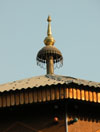 |
Rozabal, Srinagar, Kashmir
Is this the tomb of Jesus Christ? |
 |
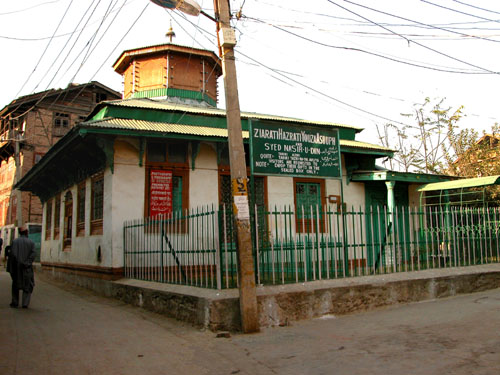
Rozabal, the mausolaeum of the profet Yuz Asaf (Jesus Christ?)
and the Islamic Saint Syed Nasr-ud-Din in Khanyar Street, Srinagar
|
The tomb of prophet Yus Asaf and saint Syed Nasr-ud-Dinis |
| The mausolaeum of the profet Yuz Asaf
and the Islamic saint Syed Nasr-ud-Dinis is today located in the middle of Srinagar's old town, Anzimar in the
Khanyar quarter. The building constructed is called "Razabal" or "Rauza
Bal". "Rauza" is a term used to denote the tomb of a celebrated
personality, someone noble, wealthy or saintly.
Anjuna, which is Sanskit for John/Johannes, built the tomb around
89AD. The tomb was first mentioned in documents from 112AD which states, that a protective building had been
constructed over the crypt.
The tomb is said to have been
tended by an Israelic looking family, in an unbroken line throughout the
centuries. |
|
Sacred Site Charter of 1766 |
In 1766, the keepers of the tomb were issued with a charter, which were
officially confirming the importance of the sacred site. The words in
the formal decree issued by the Grand Mufti ("Teacher of Islamic religious Law") Rahman Mir are
as follows:
"Here lies Yuz Asaf, who rebuilt the
Temple of Solomon at the time of
King Gopadatta, and who came as a profet to Kashmir. He ministered to
the people, declared the unity with God, and was lawgiver to the people.
Since then his tomb has been honoured by kings, state officials, high
dignitaries and the common folk". |
|
Is Yuz Asaf and Jesus the same person? |
| "Yus Asaf" is the Islamic name for
Jesus. Many ancient literary works in Kashmir testify to the fact that Yuz Asaf
and Jesus are the same person. One old manuscript desribes the shrine as
the grave of Issa Rooh-Allah, "Jesus the Spirit of God". Thousands of
the faithful makes pilgrimages to this tomb - not just Muslims, but
Hindus, Buddhists and Christians as well. The true importance of this
modest shrine has been preserved in the memory of the descendants of the
ancient Israelites to this day. They call the shrine, "The tomb of
Hazrat Issa Sahib", "The Tomb of Lord Jesus". |
|
Litterature |
|
Hassnain, Fida M.
A Search for the
Historical Jesus, Gateway Books, U.K., 1994 - ISBN
0946551
99 5
Kashmiri, Aziz,
Christ in Kashmir, Roshni Pubs, Srinagar, 1984
Kersten, Holger,
Jesus Lived in India, Element, Shaftesbury, UK, 1986
Bock, Janet, The Jesus Mystery, Aura Books, Los Angeles, 1980
Hazrat Mirza Ghulam Ahmad of
Qadian, Jesus in India, 1989
Read more about "Jesus in India":
http://en.wikipedia.org/wiki/Jesus_in_India_(book)
The lost Years of Jesus:
http://en.wikipedia.org/wiki/Jesus_in_India#Jesus_in_India
|
|
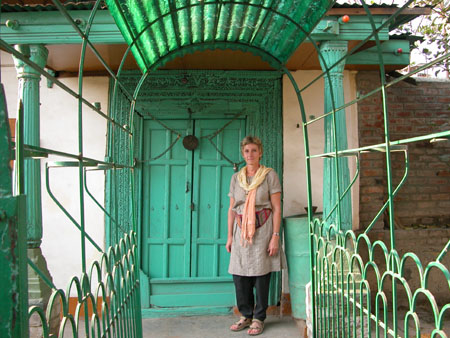
Entrance painted in Islamic colours
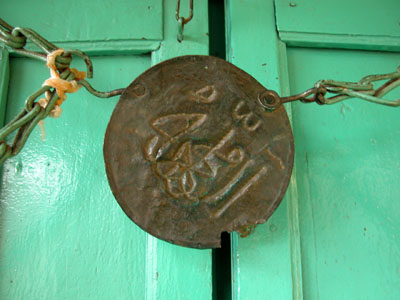
The door is sealed, but entrance is
possible.
|
The building |
| The building is rectangular in plan and a small porch has been added
to it. See plan below. Above the entrance to the actual burial chamber
is carved an inscription which declares, that:
"Yuz Azaf entered the valley of Kashmir many centuris ago and his life
was dedicated to manifesting the truth."
The shrine has in recent years been redecorated and the colours have
been changed to green and pink, which belongs to the Islamic tradition.
Between 2005 and 2007 a small tower with coloured lightbulbs has been
added. |
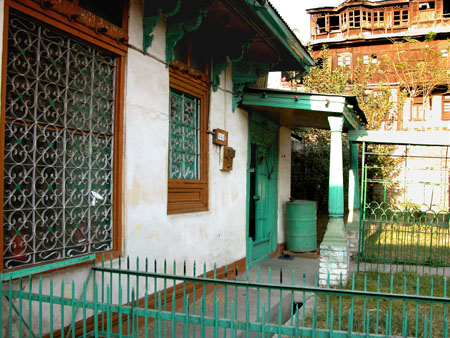
Entrance with the small porch added to the building later.
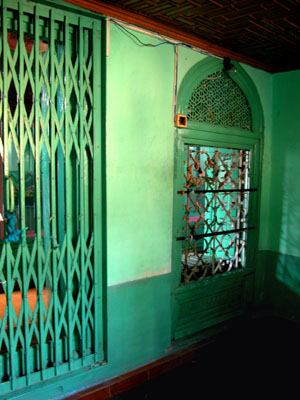
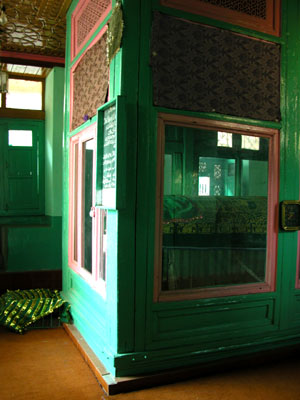
The hall way and the first sight inside the burial chamber.
|
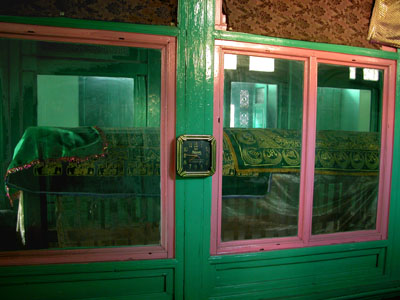
The wooden framework covering over the gravestones |

Old photo of the wooden framework
before the shrine was altered |
|
plan over the building is on the way |
Two different tombstones is in the floor of the innermost
burial chamber, surrounded by wooden railings to which strong beams have
been added, covered over by a heavy cloth. The larger tombstone is that
of Yuz Asaf, the smaller that of the Islamic saint Syed Nasr-ud-Din, who
was buried here in the 15th century.
Both tombstones are aligned north-south, following Islamic custom. As
is also usual for Islamic tombs in India, these tombstones are just
markers, the actual graves are located in a crypt below the floor of he
building. A tiny opening which allowed the visitor too look down
in the burial chamber below is now cemented.
The sarcophagus containing the earthly remains of Yuz Azaf is
aligned east-west, in accordance with Jewish custom.
This makes a
clear proof that Yuz Azaf could not have been an Islamic saint. Among
the Hindus and Buddhists, only ascetics and saints are buried, all
others are cremated. So here lies a person who was revered as a saint
even before the arrival of Islam, at a time when Kashmir was Buddhist
and Hindu country. |
|
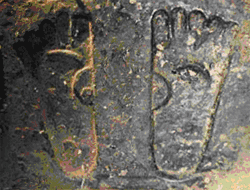
The carved Footprints
It has always been the custom and practise of worshippers to place
candles around the tombstones. When the century-old layes of wax were
removed in 1975 from an elevated stone in the inner chamber of the
tomb, a sensational discovery was made:
"A pair of footprints was carved
into the stone and beside them lay a wooden crucifix and a rosary."
The Scars from the crucifiction
The sculptor of the relief has very clealy shown the scars from the crucifixtion wounds. The position of the wounds even shows, that the left
foot has been nailed over the right, a fact that has been confirmed by
the bloodstains on the Turin Shroud.
Crucifixtion was unknown as a form
of death penalty in India, so the sculptor carved according to what had
been visible. Or was he instucted by John, the disciple of Jesus, who
built the tomb and knew about the scars firsthand? |
Pada worship
Pada worship
or worship of the feet or sandals (both are called Padas) of a
living saint is an
ancient religious practise for devout believers and spiritual
seekers in the Hindu tradition and also troughout other parts of Asia. For Hindus it is considered the
highest form of worship: The greater the saint, the greater
the blessing. The feet is believed to contain all the powers
of the saint, as all the energy channels of the body
ends in the feet.
The energies in saintly feet can be so powerful that you can
virtually die, if you do not have permission from the saint to
touch his feet.
This saintly energy is installed in the carved stone Padukas
and believed to be there even after the death of the saint. Te
Padukas are considered extremely sacred and
can be found in Hindu temples and shrines all over India.
|
|
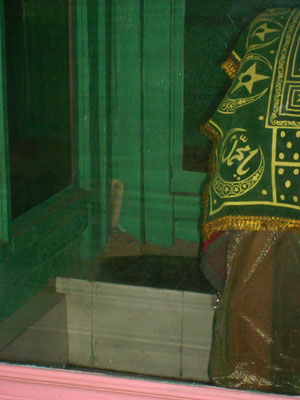
The stone with the carving of the sacred feet |
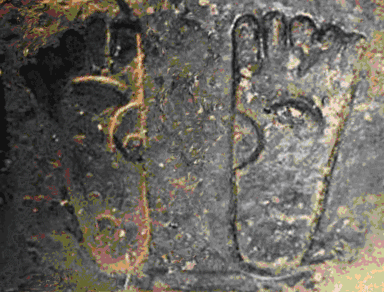
The sacred feet of Yuz Asaf, Jesu Christ?
|
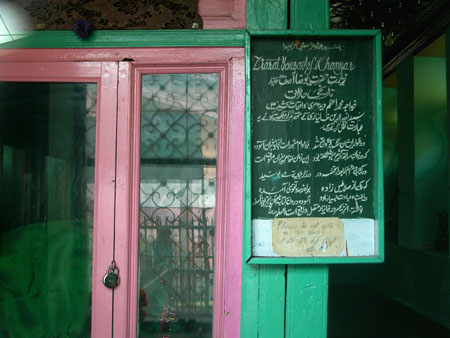
Signboard in the southern part of the shrine,
naming the saints who is buried in the shrine.
|

Inside the burial chamber before it was altered
and painted according to Islamic tradition
|
A
translation of the Kashmiri poem about the tomb of Jesus Christ:
Here
lies the Tomb,
so famous and so illuminant,
Sanctum of the Prophet.
Whosoever bows before it,
receives light and consolation.
Tradition has it,
there was a prince,
accomplished, pious and great.
He
received the Kingdom of God,
was devoted to the Almighty,
was commanded to be the Prophet,
the true guide of the devotees.
Here
lies the Tomb of the Prophet,
who is known as Yuz-Asaf. |
|
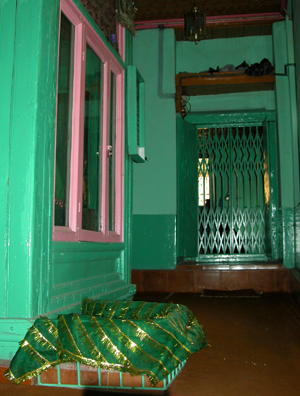 |
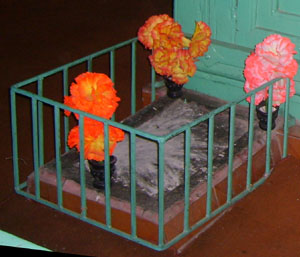
The hole, where the crypt,
beneath the ground level was visible,
is now cemented and covered with a cloth. |
|
Opening of the shrine |
|
Opening of the shrine
has been attempted in 1984 according to Holger Kersten, "Jesus lived in India" p. 231.
But interestingly enough: "A shootout broke out on
the evening before the planned opening, with the loss of seven lives." Since the
summer 1889 a situation near cicil war has developed in Kashmir due to
the activities of various guerilla groups. The old town area of Srinagar,
in which the tomb is located, was the central lair of the underground
fighters in those days. The whole town of Srinagar and the Kashmir
province is nowadays patrolled by 700.000 Indian troops. It is possible
and fairly safe to visit the shrine also for foreign visitors.
In wiev of the fact, that the tomb is situated
right next to the River Jhelum and must have been flooded many times
over the past two thousand years, not too much should be expected from
the opening of the underground Sarcophagus.
Holger Kersten, "Jesus lived in India" p. 232
|
|
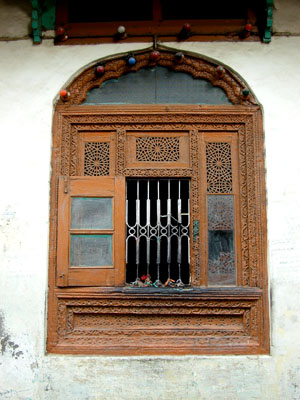
Window in the old design,
not altered with Islamic colours
|
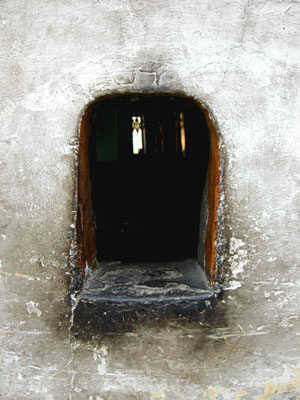
A hole in the wall where, in former time by touch,
a
strange smell of musk was emanating
|
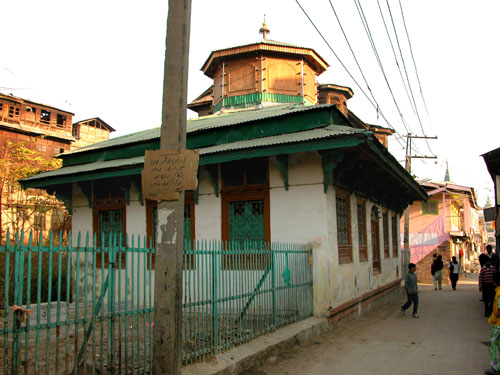
Backside of the mausolaeum with a few graves ...
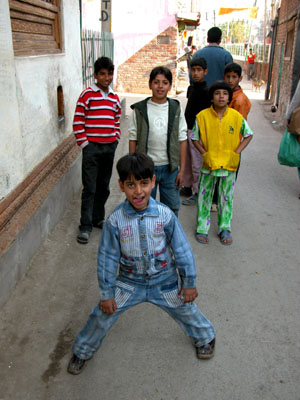
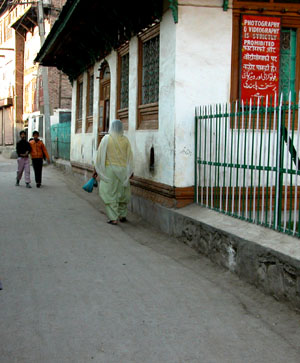
... where children are playing and life goes on in its normal rythm
|
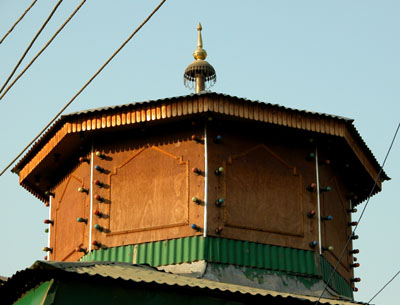
The tower has been added between 2005 and 2007 |
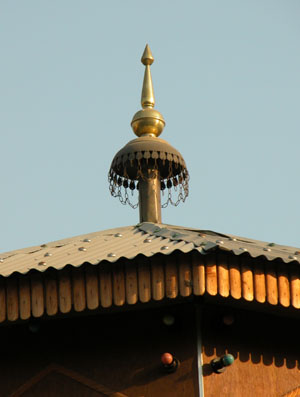 |
|
Faith and/or facts? |
| The pages on this website about Christ in Kashmir
are based upon the assumption, that Jesus survived the crucifixtion.
Fleeing from His grave, Jesus went in hiding from the Romans and other
persecuters outside
Jerusalem.
After recovering from His wounds, He travelled incognito, perhaps even
under a another name, with caravans along the "Silk Road", the ancient
trade route from Europe to the far east. Yuz Azaf or Jesus Christ arrived in Kashmir aproximately year 60AD. He
stayed in Kashmir,
where many other Israelites lived. Ten of the twelve tribes of Israel had migrated
to this "Promised Land", in the 6th century BC, ie. long time before
Jesus' birth.
Jesus came because he was the Messiah of the Israelittes, and he had, in
clear words, declared that he was sent to serve the lost sheep in the
house of Israel.
After year 80AD he was entombed in Srinagar.
These assumptions is based on several scriptures: The apocryphal texts and
non-canonized gospels found in Qumran, Israel and Nag Hamadi, Egypt,
scriptures found in Tibetan monestaries, historians over the centuries,
inscriptions in temples and at the Rozabal Mausolaeum, the Sanskrit
texts Bahavishya Maha Purana and Rajatarangini, Persian texts and last but not the least: The age old oral tradition from the different parts of India
and other countries, where Jesus is supposed to have been. Where the
local people long time ago had seen a man, "With fair hair and a face
shining like the sun, who called Himself, the son of God."
Jesus
Christ was an enlightend master without attachments of any kind to
either places, people or things. He was a travelling saint, who spread "The
Word" Himself. The knowledge about "The Kingdom to come", which
is as difficult to understand today, as it was for His closest disciple,
he taught himself. It is
likely and very well documented, that Jesus Himself created the the world
religion, that we know today, by travelling and teaching in most of the known world of
those days.
Faith and belief is challenged, but is lack of faith in
the
historical evidences, not deep down lack of faith in Him?
|
|
Three theories about Christ after the crucifixtion |
Three main theories exixts conserning where
Jesus Christ lived His elder days, perhaps married, had children and
where He may be buried. All three theories are well documented, therefor
it is for the reader to decide, what seems right for you:
1. Srinagar, Kashmir
2. France
3. Shingou, Aomori, Japan - "Jesus lived in Japan" by Ahtisham Fida,
Masto Oki & Yoshiaki Sora, Srinagar 1996, ISBN 81-900630-1-4
See fotos from Shingou,
Aomori on this link:
http://www.zetetique.ldh.org/herai_en.html
|
|
mukti4u2@gmail.com |
 |
www.mukti4u2.dk |
mukti4u2.dk
►
created by
BP
|